Topcoats for Painting Furniture
Imagine working hard on a piece of furniture you thrifted; painting it with your favorite color, only to find it with scratches a couple of days later. How frustrating! This is why I use a topcoat for painting furniture in my projects.
Topcoating painted furniture helps prevent scratches, dings, and scuff marks from our kids, pets, or everyday life. Here are our best tips and tricks on how to apply a clear topcoat to painted furniture. Learn more about furniture painting tools and supplies here!

Some paints don’t need a top coat. But most paints need an added layer of protection to prevent moisture, heat, and scratches from damaging the paint.
Top coats can also change the sheen of furniture to matte, satin, semi-gloss, or gloss.
What Do I Use For Top Coat on Painted Furniture?
There are two common top coats you can choose from when painting furniture: polyurethane or wax.
As an Amazon Associate, I earn from qualifying purchases. I also may earn from other qualifying purchases with other companies or get free product to review and use. All opinions are my own.
Polyurethane vs Wax
Choosing between polyurethane and wax will depend on the paint that will be coated and the kind of sheen that you want. Learn more about wax vs polyurethane here.
Wax
Wax can seal porous paints like milk paints and chalk paints. The porous texture of these paints allows the wax to be absorbed better into the surface; this is how it seals the paint.

However, wax requires reapplication after six months to a year because it wears down over time. Also, wax takes at least a few days to dry to the point that it doesn’t feel tacky or oily.
The finish created with wax is often a matte or satin sheen, depending on how much you buff it out after applying it.
My favorite waxes are The Real Milk Paint Soft Wax or Fusion Mineral Paint’s Beeswax.
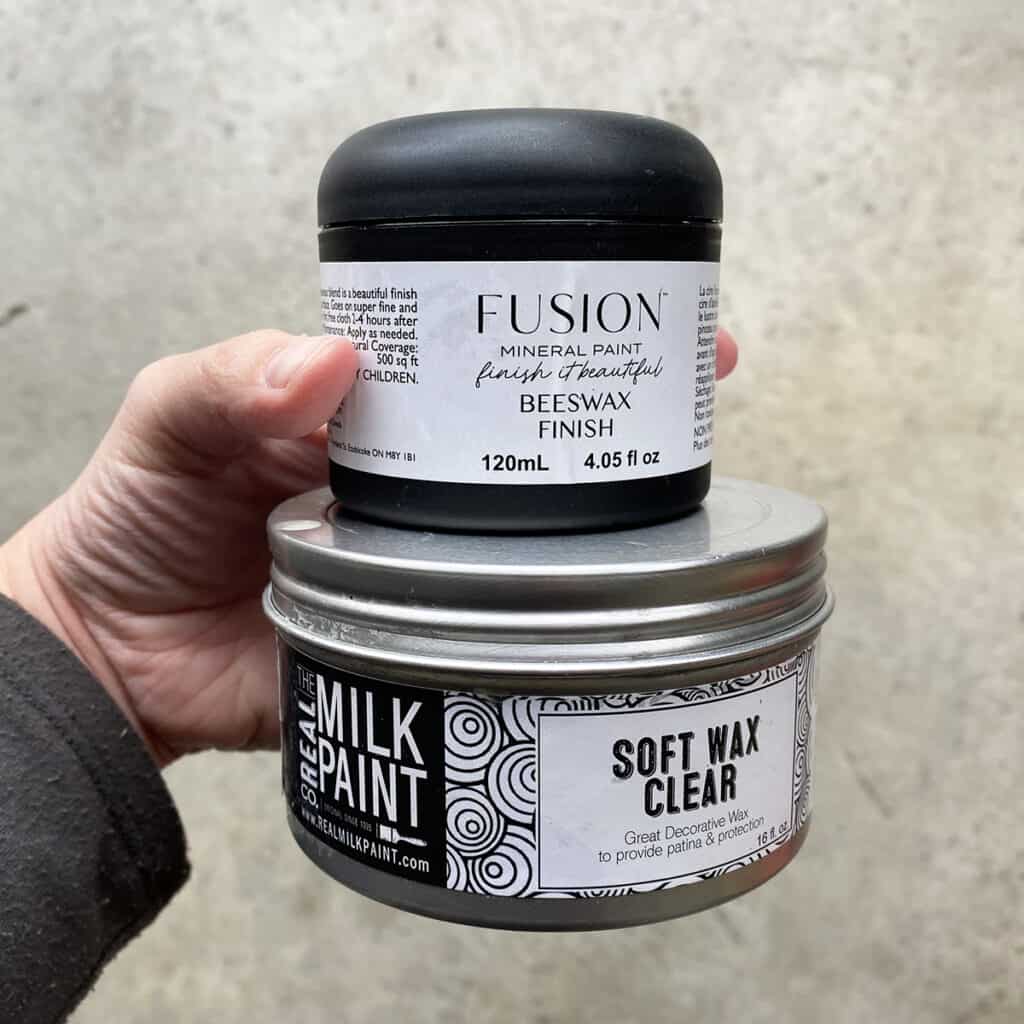
For example, I brushed some wax over matte paint in this repainted flat file cabinet to give it a tiny bit of sheen for a cleaner and smoother look. I love how it turned out!
Polyurethane/Polyacrylic
But when it comes to durability, polyurethane topcoats last longer.
Polyurethane topcoats are good for furniture placed in high-traffic areas because it provides tough protection from the elements that can damage the paint.
I use polyurethane as a topcoat 99% of the time. With chalk paint, milk paint, acrylic paint, mineral paint, etc. Learn more about the best polyurethane for furniture here.
Water-based polyurethane dries quicker than wax. It dries to the touch in less than 2 hours, but I wait at least 24 hours before I put it into very light use.
But it takes 30 days to cure to as hard as it’s going to get.. which is about the same time as it takes wax to cure.
Unlike wax, it doesn’t require reapplication in less than a year. With a water-based polyurethane topcoat, the paint can really hold up longer without many signs of wear.
My favorite polyurethane is Varathane water based polyurethane in satin.

Polyurethane vs Polyacrylic
Are you confused between the two? Well, you’re not alone. So what’s the difference between polyurethane and polyacrylic?
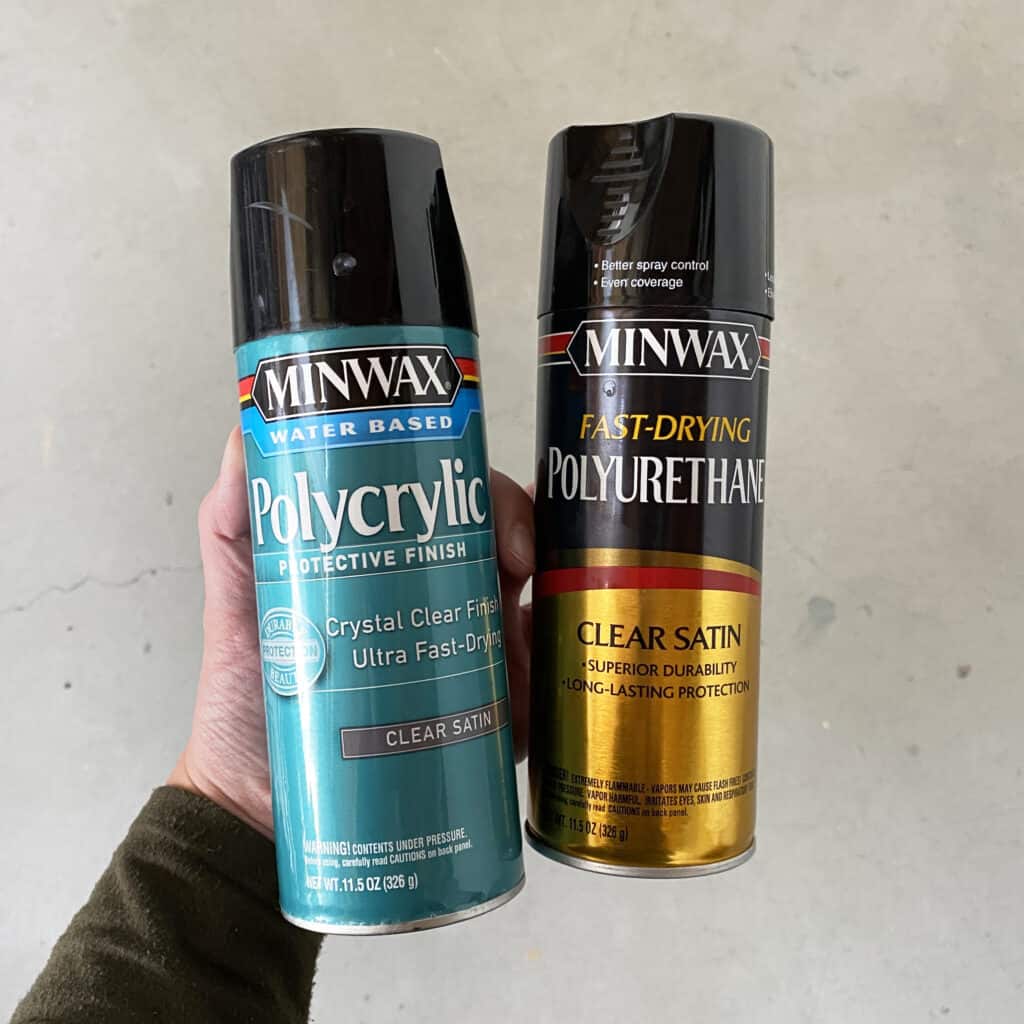
Polyurethane comes in a water-based formula and an oil-based formula. While polyacrylic is only water-based.
Polyacrylic topcoats were formulated to be more environmentally friendly, having less Volatile Organic Compounds (VOC), making them safer to use than oil-based polyurethane.
Oil-based polyurethane topcoats are more recommended for outdoor furniture because they can withstand heat and water better.
So if you wanna makeover your outdoor furniture, oil-based topcoats are the most durable option. This Minwax oil based polyurethane is my favorite oil-based polyurethane.
Learn more about the features, pros and cons, and how-to’s of Minwax polyurethane spray here.
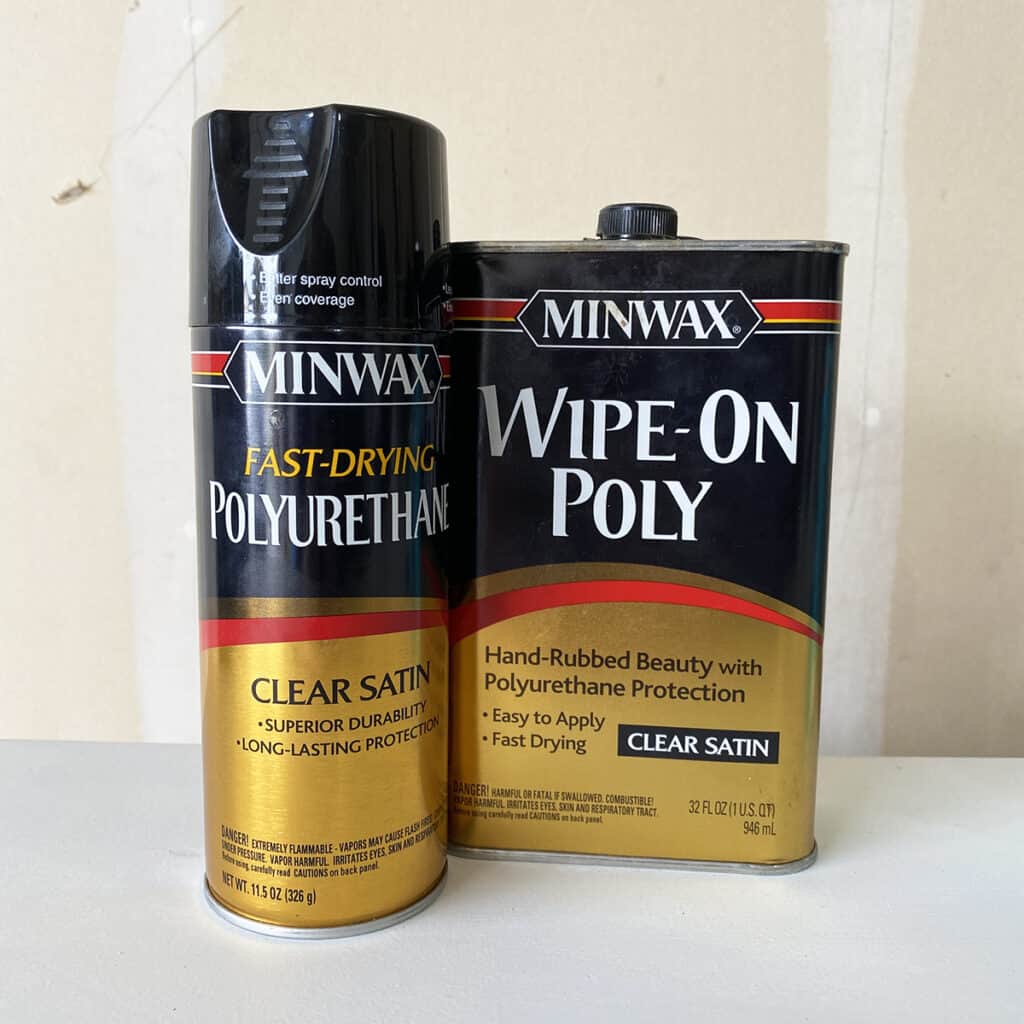
However, oil-based polyurethane has a stronger odor and takes longer to dry.
Oil-based polyurethane also dries in an amber or yellow color, while most water-based polyurethane or polyacrylic dry crystal clear.
Learn more about the difference between polycrylic vs polyurethane here.
How To Apply Polyurethane to Painted Furniture
First, mix it well. This applies to polyacrylic as well as water-based and oil-based polyurethane topcoats.
We need to mix it well because the flattening material (that makes the topcoat into different sheens) settles at the bottom of the can.
If the flattening material is not mixed well with the polyurethane, the surface of the painted furniture will have an uneven sheen. Some spots will look glossy, while others will look foggy or matte.
Also, when it is not mixed well, the ingredients will not work as well, and it will not be as durable as it should be.
Applying Polyurethane to Painted Furniture by Hand
When I’m top coating a dark colored paint, I like adding a bit of the water-based dark paint, that I painted the furniture with, into the water-based polyurethane.
This tints the polyurethane and helps prevent a foggy finish when using the topcoat by itself.
I like using a sponge when applying polyurethane over painted furniture by hand. I’ve even tried the trick of putting the sponge in a pantyhose or nylon stocking, and the finish does look even better!

It still leaves some streaks behind, but it’s the best way to create a streak-free topcoated finish by hand.
Then, I wipe it evenly over the painted furniture. We want that clean and smooth finish without thin spots in some areas and big globs in other areas of the furniture.
Watch a clip in this video to see how to apply polyurethane by hand.
Tips for Applying Polyurethane by Hand
- To avoid drips, I don’t put too much polyurethane on the sponge, especially when working on the edges.
- I like starting on the edges and then applying it to the middle of the furniture.
- I wipe it onto the top of the furniture from side to side in long strokes.
- It’s also good to apply it in the direction of the wood grain because it’s easier to hide any imperfections.
- I try not to go back over the area I have already put the topcoat. It will turn out messy since it dries quickly.
- Then, make sure to let the first coat dry completely (usually a couple of hours) before applying the second coat. I apply 2-3 coats usually.
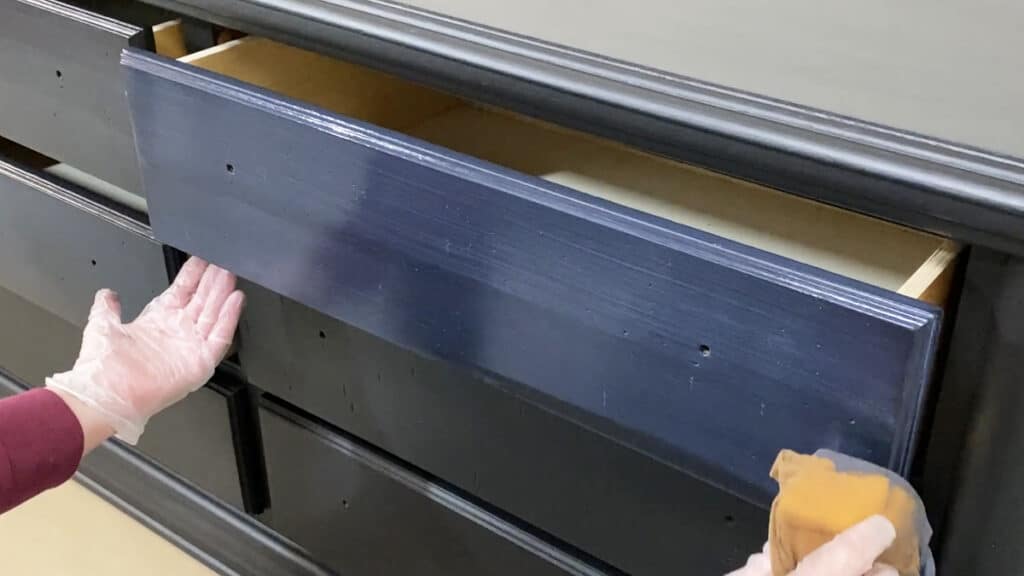
How to Spray Polyurethane
I use a paint sprayer like the Wagner FLEXiO 3000 HVLP paint sprayer when top coating painted furniture with water-based polyurethane.
It gets the job done faster and enables me to create a streak-free and brush mark free finish easily!
When using a paint sprayer, I like to thin the water-based polyurethane with a small amount of water so that the topcoat dries more smoothly.
I also like to run the polyurethane through a mesh paint filter before it goes into the sprayer, which helps the sprayer not get clogged up.
Here are all of my tricks for how to spray polyurethane. Also, if you’re curious, here’s my list of the best HVLP paint sprayers for furniture.
Learn more on how to apply polycrylic to painted furniture here and check out the comparison of spray polyurethane vs brush on polyurethane here.
What is the Best Top Coat for Painted Furniture?
My personal favorite topcoat is the Varathane Ultimate Polyurethane Water Based Crystal Clear Finish.
I’ve never experienced my white paint turning yellow when I used it. (A common problem when using polyurethane over white or light-colored paint is that it turns yellow.)
There are also a variety of finishes you can choose from (matte, satin, semi-gloss, or gloss sheens). I typically use satin for my projects.

Even though a wax topcoat can be applied over milk paints or chalk paints, water-based polyurethane is my favorite topcoat overall.
Water-based polyurethane can be used over latex paint, acrylic paint, mineral paints… almost any paint (alkyd waterborne paints don’t need a topcoat, and neither do oil-based paints).
Check out how I used polyurethane on painting furniture with latex paint.
But since most furniture paint is water-based and not alkyd waterborne, you are safe to use it most of the time. Wax needs to soak into the paint, so wax isn’t always an option.
I personally like to spray water-based polyurethane onto my painted furniture because it’s so much faster than any other method, and it creates a streak-free look.
And knowing that it will last longer with less maintenance is a major plus!
Top Coat for Chalk Paint
The matte finish of chalk paint looks lovely on a piece of furniture by itself. But chalk paint really needs to be top coated… even if it says it doesn’t need it.
Chalk paint can be top coated with either wax or a water-based polyurethane. Here are a couple of reasons you need to use a topcoat for chalk painted furniture.
- Chalk paint isn’t water resistant.
- It gets dirty easily (when you touch it with clean hands, you can see white marks left where you touched it).
- It can scratch easily, especially if the furniture wasn’t sanded or primed beforehand.
- It absorbs stains easily, and without a topcoat you can’t wipe them off.
So just imagine how kids or pets can easily “put some art” on your chalk painted furniture if it doesn’t have a topcoat.
How to Paint Polyurethane over Chalk Paint
While wax works well for porous paints like chalk paint, it is not as durable and requires a touch-up after a few months. This is why I prefer to use a water based polyurethane topcoat.
You can use a topcoat paintbrush or a foam sponge, or a paint sprayer to apply it. For a softer and smoother finish, sand between coats with 400 grit sandpaper.
Check out how we painted polyurethane over chalk paint on this homemade chalk painted dresser.
If this information all looks familiar, it is. Haha. It’s the same process in applying polyurethane to painted furniture by hand.
How to Apply Wax to Chalk Paint
To apply wax, use a stiff-bristled brush or any lint-free cloth; I’ve even used old socks on my projects.

Just like with polyurethane, make sure the chalk paint has dried for at least 24 hours. Or else the buffing can rub off the chalk paint.
Apply the wax to your chalk painted furniture. Then rub the excess wax back off with a lint-free cloth.
Remember that the more you rub the surface with wax, the more glossy it will get. So if you want a less glossy finish, do not rub the surface too much.
Then let the wax dry for a few days. Wax takes longer to dry than water-based polyurethane, so your furniture might feel tacky until the wax dries completely after about 30 days.
I like using the Real Milk Paint Soft Wax. It doesn’t smell bad, and it spreads easily… it’s as smooth as butter!
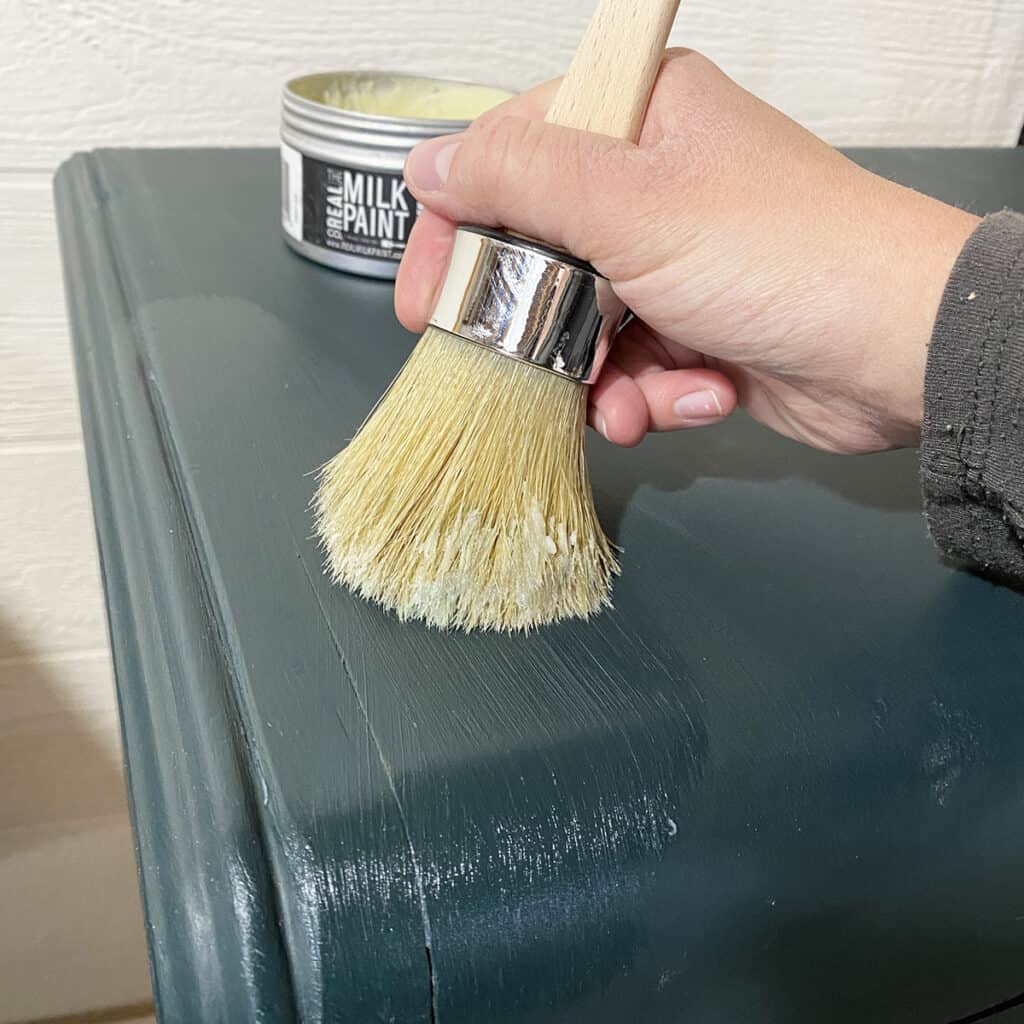
I also really like Fusion Mineral Beeswax. It’s similar to soft wax in that it doesn’t smell bad, it spreads easily, and it produces a better streak-free finish than other waxes.
You should also check this detailed guide on how to apply Waverly wax over chalk paint and how to use Waverly antique wax for more information.
Read this detailed post on how to chalk paint furniture for more tips on using chalk paint and wax. Or watch a clip of this video to see how to apply wax to chalk paint.
Here are more tips about topcoats for painting furniture below.
Can You Paint Over Polyurethane?
Yes, you can… if you prepare it for paint first. Lightly scuff sand it with 220 grit sand paper to help the paint stick to it. Then clean up the dust.
For even better adhesion, apply a primer to the surface before you paint. This post shows how to choose the best primer for painting furniture.
Can You Paint Over Wax?
Many will say no and will not recommend it, because the oils from the wax will keep it from bonding to the surface. And I agree.
However, a fellow painter, Marian, a.k.a Miss Mustard Seed, shares how she does it. According to her, after the wax is cured (after 30 days), she can repaint her furniture without any issues.
I can totally see how her method would work well. As long as you use a paint with excellent adhesion. You can read more about how to repaint over wax here.
But, when in doubt, it’s best to remove the wax from the chalk painted furniture before trying to repaint it.
How to Remove Wax from Chalk Painted Furniture?
You can remove wax from chalk painted furniture with mineral spirits.
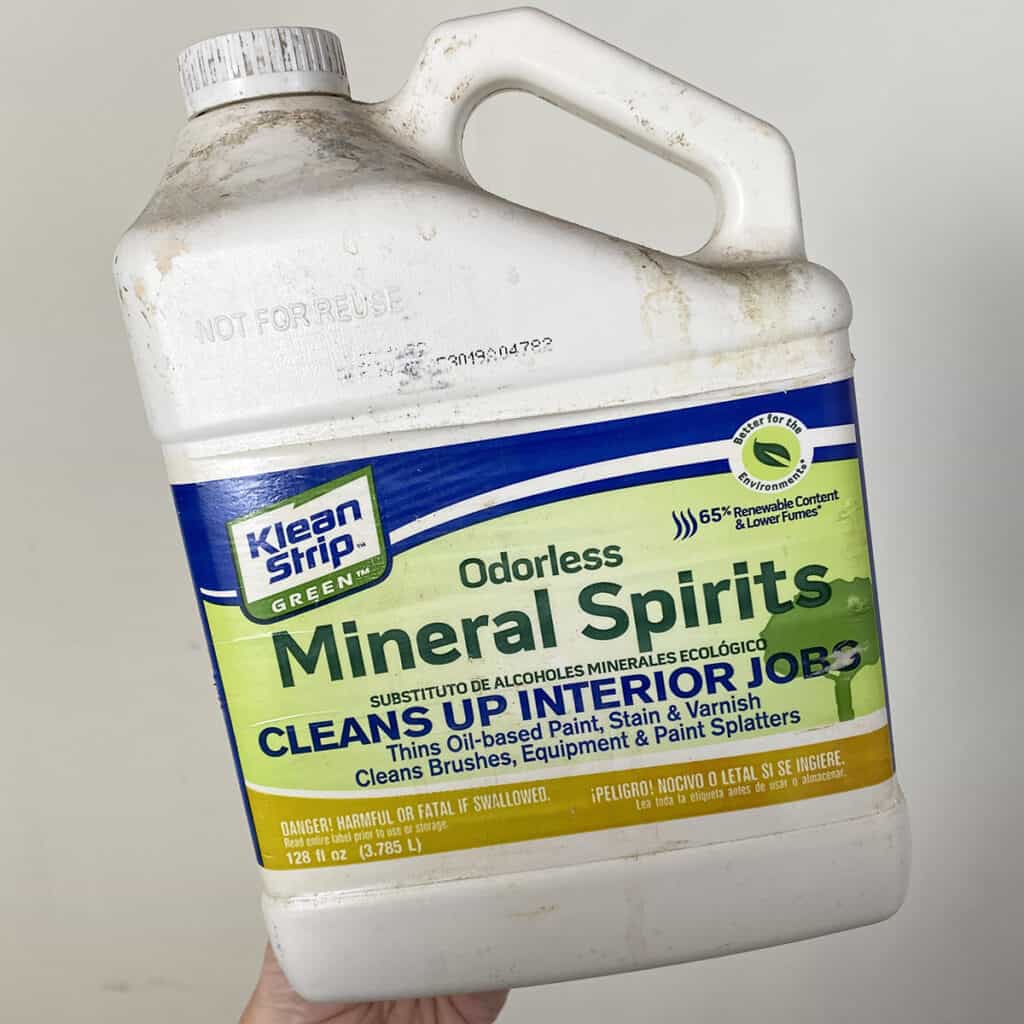
Dampen a piece of cloth with mineral spirits and apply generously over the furniture’s surface. Rub steel wool to remove it even more.
Do this until you can no longer see any trace of wax on the cloth when wiping the surface.
Mineral spirits is often combustible, so be sure to lay your mineral spirits rag flat to dry outside before throwing it away.
If you want to remove the paint and wax, here’s how to strip paint from wood.
More Resources on Furniture Painting Tools and Supplies
- Best Paint Brushes for Painting Furniture
- Best Rollers for Painting Furniture
- The Best Paint for Furniture
- Types of Paint for Furniture
- Spray Paint vs Brush Paint Furniture
Follow us on YouTube to get more tips for painting furniture.
Or share your project with us on our Facebook Group and be part of our community. See you there!

I painted a dresser with General Finishes Milk paint snow white. I’m reading many sources stating that topcoating with poly may yellow it. I’m torn between using Varathane ultimate satin, which I have, or purchasing General Finishes brushable white enamel. I appreciate your advice on this. Thank you.
Any paint can turn a little yellow with a topcoat. Personally, I don’t think you would notice it if it did happen. I have a piece that I painted with white chalk paint and sprayed varathane waterbased poly on it 6 years ago. It still looks very white to me!
You could totally do the brushable enamel though if you think it would bug you.
Thank you very much!